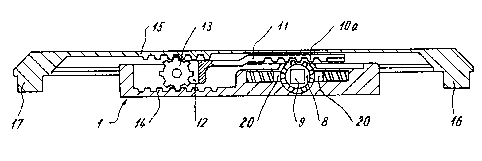Une partie des informations de ce site Web a été fournie par des sources externes. Le gouvernement du Canada n'assume aucune responsabilité concernant la précision, l'actualité ou la fiabilité des informations fournies par les sources externes. Les utilisateurs qui désirent employer cette information devraient consulter directement la source des informations. Le contenu fourni par les sources externes n'est pas assujetti aux exigences sur les langues officielles, la protection des renseignements personnels et l'accessibilité.
L'apparition de différences dans le texte et l'image des Revendications et de l'Abrégé dépend du moment auquel le document est publié. Les textes des Revendications et de l'Abrégé sont affichés :
| (12) Brevet: | (11) CA 2119400 |
|---|---|
| (54) Titre français: | MECANISME DE COMMANDE POUR PORTE OU FENETRE |
| (54) Titre anglais: | SLEEVE ACTUATOR FOR A WINDOW OR A DOOR |
| Statut: | Périmé et au-delà du délai pour l’annulation |
| (51) Classification internationale des brevets (CIB): |
|
|---|---|
| (72) Inventeurs : |
|
| (73) Titulaires : |
|
| (71) Demandeurs : |
|
| (74) Agent: | SMART & BIGGAR LP |
| (74) Co-agent: | |
| (45) Délivré: | 2004-12-14 |
| (22) Date de dépôt: | 1994-03-18 |
| (41) Mise à la disponibilité du public: | 1994-09-20 |
| Requête d'examen: | 2001-02-22 |
| Licence disponible: | S.O. |
| Cédé au domaine public: | S.O. |
| (25) Langue des documents déposés: | Anglais |
| Traité de coopération en matière de brevets (PCT): | Non |
|---|
| (30) Données de priorité de la demande: | ||||||
|---|---|---|---|---|---|---|
|
A locking mechanism for driving a lock bolt
comprises a housing. A pinion has an outer circumference
and is rotatably mounted in the housing. The pinion has a
plurality of teeth arid tooth gaps are disposed between
adjacent teeth. A predetermined number of the tooth gaps
have an abutment that extends outwardly substantially to the
outer circumference of the pinion. A toothed rod is coupled
to the lock bolt. The toothed rod is engaged by the pinion.
A spring loaded detent device arrest the rotational movement
of the detent in a switching position of the lock bolt.
Note : Les revendications sont présentées dans la langue officielle dans laquelle elles ont été soumises.
Note : Les descriptions sont présentées dans la langue officielle dans laquelle elles ont été soumises.

2024-08-01 : Dans le cadre de la transition vers les Brevets de nouvelle génération (BNG), la base de données sur les brevets canadiens (BDBC) contient désormais un Historique d'événement plus détaillé, qui reproduit le Journal des événements de notre nouvelle solution interne.
Veuillez noter que les événements débutant par « Inactive : » se réfèrent à des événements qui ne sont plus utilisés dans notre nouvelle solution interne.
Pour une meilleure compréhension de l'état de la demande ou brevet qui figure sur cette page, la rubrique Mise en garde , et les descriptions de Brevet , Historique d'événement , Taxes périodiques et Historique des paiements devraient être consultées.
| Description | Date |
|---|---|
| Le délai pour l'annulation est expiré | 2009-03-18 |
| Lettre envoyée | 2008-03-18 |
| Inactive : CIB de MCD | 2006-03-11 |
| Inactive : CIB de MCD | 2006-03-11 |
| Inactive : CIB de MCD | 2006-03-11 |
| Inactive : CIB de MCD | 2006-03-11 |
| Accordé par délivrance | 2004-12-14 |
| Inactive : Page couverture publiée | 2004-12-13 |
| Préoctroi | 2004-09-28 |
| Inactive : Taxe finale reçue | 2004-09-28 |
| Lettre envoyée | 2004-09-01 |
| Un avis d'acceptation est envoyé | 2004-09-01 |
| Un avis d'acceptation est envoyé | 2004-09-01 |
| Inactive : Approuvée aux fins d'acceptation (AFA) | 2004-08-19 |
| Modification reçue - modification volontaire | 2004-03-30 |
| Inactive : Dem. de l'examinateur par.30(2) Règles | 2003-10-02 |
| Inactive : Dem. traitée sur TS dès date d'ent. journal | 2001-03-09 |
| Lettre envoyée | 2001-03-09 |
| Inactive : Renseign. sur l'état - Complets dès date d'ent. journ. | 2001-03-09 |
| Toutes les exigences pour l'examen - jugée conforme | 2001-02-22 |
| Exigences pour une requête d'examen - jugée conforme | 2001-02-22 |
| Demande publiée (accessible au public) | 1994-09-20 |
Il n'y a pas d'historique d'abandonnement
Le dernier paiement a été reçu le 2004-02-17
Avis : Si le paiement en totalité n'a pas été reçu au plus tard à la date indiquée, une taxe supplémentaire peut être imposée, soit une des taxes suivantes :
Veuillez vous référer à la page web des taxes sur les brevets de l'OPIC pour voir tous les montants actuels des taxes.
| Type de taxes | Anniversaire | Échéance | Date payée |
|---|---|---|---|
| TM (demande, 4e anniv.) - générale | 04 | 1998-03-18 | 1998-02-23 |
| TM (demande, 5e anniv.) - générale | 05 | 1999-03-18 | 1999-03-05 |
| TM (demande, 6e anniv.) - générale | 06 | 2000-03-20 | 2000-02-07 |
| Requête d'examen - générale | 2001-02-22 | ||
| TM (demande, 7e anniv.) - générale | 07 | 2001-03-19 | 2001-02-28 |
| TM (demande, 8e anniv.) - générale | 08 | 2002-03-18 | 2002-02-21 |
| TM (demande, 9e anniv.) - générale | 09 | 2003-03-18 | 2003-02-04 |
| TM (demande, 10e anniv.) - générale | 10 | 2004-03-18 | 2004-02-17 |
| Taxe finale - générale | 2004-09-28 | ||
| TM (brevet, 11e anniv.) - générale | 2005-03-18 | 2005-02-22 | |
| TM (brevet, 12e anniv.) - générale | 2006-03-20 | 2006-03-09 | |
| TM (brevet, 13e anniv.) - générale | 2007-03-19 | 2007-02-27 |
Les titulaires actuels et antérieures au dossier sont affichés en ordre alphabétique.
| Titulaires actuels au dossier |
|---|
| SCHUCO INTERNATIONAL KG |
| GEBR. GOLDSCHMIDT BAUBESCHLAGE GMBH |
| Titulaires antérieures au dossier |
|---|
| HANS-GERD GOLDSCHMIDT |